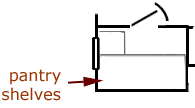The larder or pantry in a typical 1940s UK suburban kitchen
Houses on the larger 1930s-bult housing estates, had a separate small walk-in room for food storage which led off from the kitchen. It was called the larder or the pantry. Smaller suburban houses made do with a cupboard. This page describes the larder/pantry as it was in the 1940s.
____
By the webmaster, based childhood observations, discussions with people who lived in these houses and additional research
In our house, the walk-in room where food was stored was called the pantry, not the larder. It is possible that the two different names were originally regional, as I have found both terms used in older houses in different parts of the country.

Plan of the walk-in pantry/larder of a suburban house in the 1930s and 40s. See the plan in the 1940s kitchen for how the pantry led off the kitchen.
We were fortunate to have a specially designed room to store food, even though it was so small that the term walk-in was only just applicable.
Design of the larder/pantry
In the 1940s of course, there were no domestic fridges but the pantry was certainly designed to keep food cool. It was always in the shade of the next house, facing the side entrance.
As a hangover from the old outdoor meat safes, the pantry window had a fanlight which was open in all weathers but covered with wire mesh to keep out flies. The shelves, walls and window sill were reminiscent of the marble surfaces in wealthy houses of the past. They were all tiled in white, like the kitchen walls.
The door of the pantry was self-closing which must also have been useful with flies around. However many a small visiting child was trapped inside while playing. It was always the first place to look when a child went missing, because they couldn't get themselves out.
The contents of the pantry
The top shelf was used for storing tinned food and other non-perishables. It was quite high and we needed a chair to get to it. The middle shelf was at eye level and was used for perishables such as milk and butter, there being no fridges.
On the lower middle shelf was the breadboard and the cutlery box. Both were made of white untreated wood, known as whitewood, and, as with our whitewood kitchen table, were scrubbed regularly with a scrubbing brush and household soap from a galvanised bucket of hot water.
Under the shelves and around the floor were stored the large enamelled bins for flour and bread.
My mother also kept the scales on the floor. They were large, of the balance style, with their own set of iron weights. As the weights were far too heavy for use in general cooking, she relied on volumes: A quarter of a half-pound pack of margarine was 2 ounces; a rounded tablespoon of flour was 1 ounce; a rounded dessert-spoon of sugar was 1 ounce, etc. It seemed to work perfectly well.
Infrequently used pots and pans were piled behind the bins.

Round enamel flour bin, typical of those used before the 1950s. Photographed at the Usk Museum.
Note the rust where the enamel has chipped.

Whitewood breadboard, photographed at a car boot sale. Ours was just like this. There was no slot for the bread knife which was kept in the knife box.

Square enamel bread bin, typical of those used before the 1950s. Photographed in York Museum. Ours was just like this but the enamel was green.
| sources | webmaster | contact |
Text and images are copyright
If you can add anything to this page or provide a photo, please contact me.




